Analyzing Bonnie and Clyde: A Psychological Study of Their Crimes
VerifiedAdded on 2023/04/24
|6
|1656
|205
Essay
AI Summary
This essay presents a psychological study of Bonnie and Clyde, analyzing their criminal behavior through the lenses of Freud's psychoanalytic theory and Sutherland's differential association theory. It delves into the backgrounds of Bonnie and Clyde, highlighting the factors that may have contributed to their life of crime. The essay explains the core concepts of both theories, linking them to the couple's actions and motivations, and discusses the significance and theoretical contributions of the study, along with its assumptions and limitations. This analysis aims to provide a deeper understanding of the psychological aspects of criminal behavior, using Bonnie and Clyde as a case study.
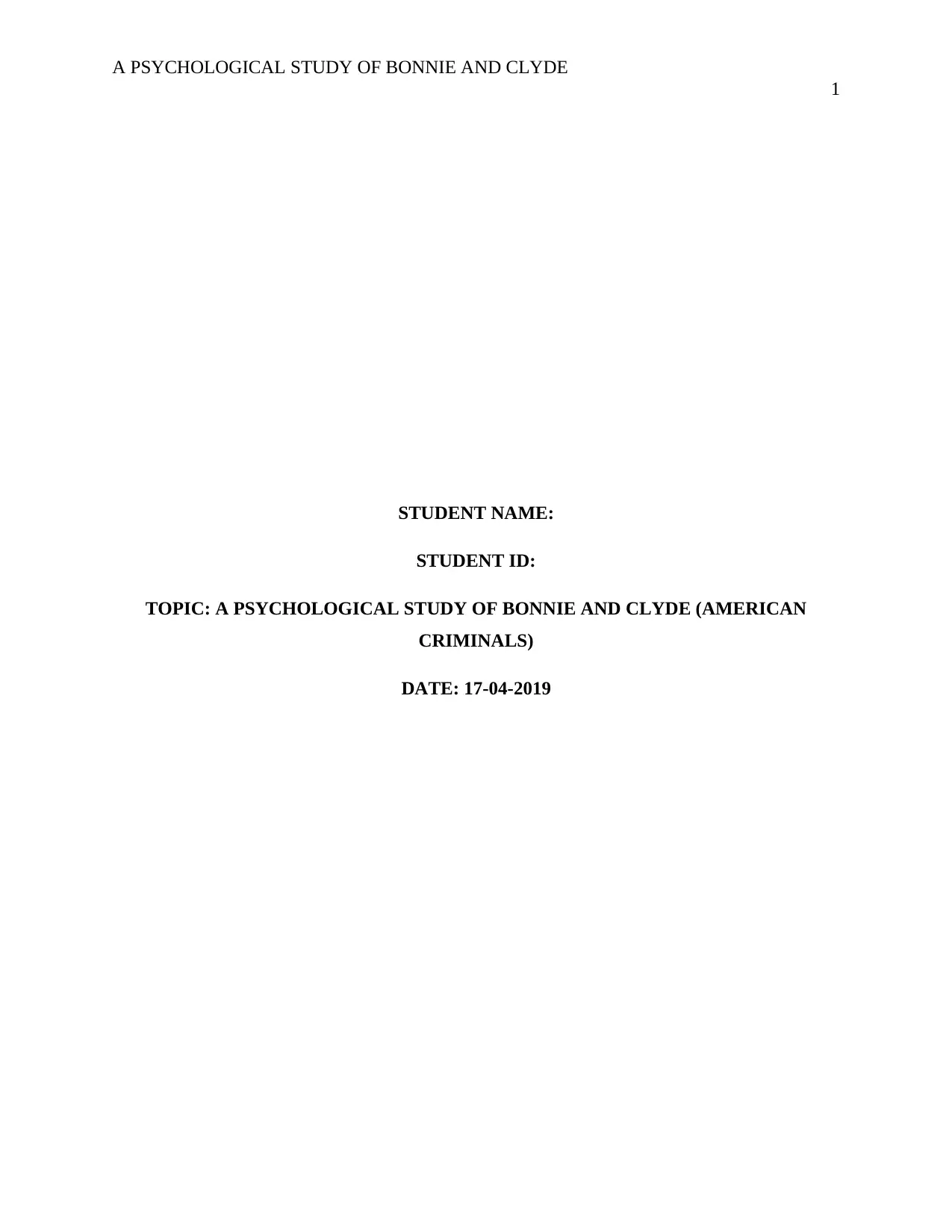
A PSYCHOLOGICAL STUDY OF BONNIE AND CLYDE
1
STUDENT NAME:
STUDENT ID:
TOPIC: A PSYCHOLOGICAL STUDY OF BONNIE AND CLYDE (AMERICAN
CRIMINALS)
DATE: 17-04-2019
1
STUDENT NAME:
STUDENT ID:
TOPIC: A PSYCHOLOGICAL STUDY OF BONNIE AND CLYDE (AMERICAN
CRIMINALS)
DATE: 17-04-2019
Paraphrase This Document
Need a fresh take? Get an instant paraphrase of this document with our AI Paraphraser
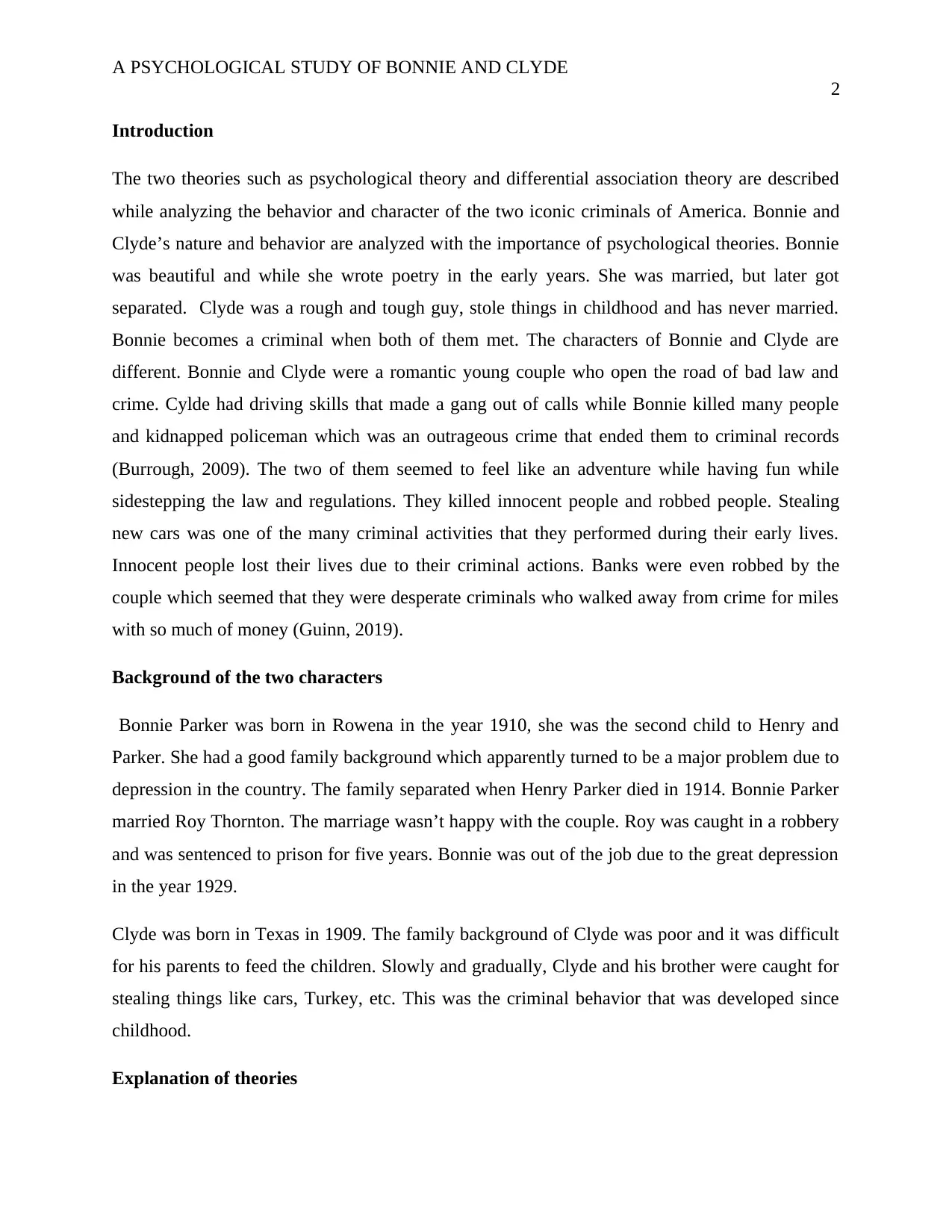
A PSYCHOLOGICAL STUDY OF BONNIE AND CLYDE
2
Introduction
The two theories such as psychological theory and differential association theory are described
while analyzing the behavior and character of the two iconic criminals of America. Bonnie and
Clyde’s nature and behavior are analyzed with the importance of psychological theories. Bonnie
was beautiful and while she wrote poetry in the early years. She was married, but later got
separated. Clyde was a rough and tough guy, stole things in childhood and has never married.
Bonnie becomes a criminal when both of them met. The characters of Bonnie and Clyde are
different. Bonnie and Clyde were a romantic young couple who open the road of bad law and
crime. Cylde had driving skills that made a gang out of calls while Bonnie killed many people
and kidnapped policeman which was an outrageous crime that ended them to criminal records
(Burrough, 2009). The two of them seemed to feel like an adventure while having fun while
sidestepping the law and regulations. They killed innocent people and robbed people. Stealing
new cars was one of the many criminal activities that they performed during their early lives.
Innocent people lost their lives due to their criminal actions. Banks were even robbed by the
couple which seemed that they were desperate criminals who walked away from crime for miles
with so much of money (Guinn, 2019).
Background of the two characters
Bonnie Parker was born in Rowena in the year 1910, she was the second child to Henry and
Parker. She had a good family background which apparently turned to be a major problem due to
depression in the country. The family separated when Henry Parker died in 1914. Bonnie Parker
married Roy Thornton. The marriage wasn’t happy with the couple. Roy was caught in a robbery
and was sentenced to prison for five years. Bonnie was out of the job due to the great depression
in the year 1929.
Clyde was born in Texas in 1909. The family background of Clyde was poor and it was difficult
for his parents to feed the children. Slowly and gradually, Clyde and his brother were caught for
stealing things like cars, Turkey, etc. This was the criminal behavior that was developed since
childhood.
Explanation of theories
2
Introduction
The two theories such as psychological theory and differential association theory are described
while analyzing the behavior and character of the two iconic criminals of America. Bonnie and
Clyde’s nature and behavior are analyzed with the importance of psychological theories. Bonnie
was beautiful and while she wrote poetry in the early years. She was married, but later got
separated. Clyde was a rough and tough guy, stole things in childhood and has never married.
Bonnie becomes a criminal when both of them met. The characters of Bonnie and Clyde are
different. Bonnie and Clyde were a romantic young couple who open the road of bad law and
crime. Cylde had driving skills that made a gang out of calls while Bonnie killed many people
and kidnapped policeman which was an outrageous crime that ended them to criminal records
(Burrough, 2009). The two of them seemed to feel like an adventure while having fun while
sidestepping the law and regulations. They killed innocent people and robbed people. Stealing
new cars was one of the many criminal activities that they performed during their early lives.
Innocent people lost their lives due to their criminal actions. Banks were even robbed by the
couple which seemed that they were desperate criminals who walked away from crime for miles
with so much of money (Guinn, 2019).
Background of the two characters
Bonnie Parker was born in Rowena in the year 1910, she was the second child to Henry and
Parker. She had a good family background which apparently turned to be a major problem due to
depression in the country. The family separated when Henry Parker died in 1914. Bonnie Parker
married Roy Thornton. The marriage wasn’t happy with the couple. Roy was caught in a robbery
and was sentenced to prison for five years. Bonnie was out of the job due to the great depression
in the year 1929.
Clyde was born in Texas in 1909. The family background of Clyde was poor and it was difficult
for his parents to feed the children. Slowly and gradually, Clyde and his brother were caught for
stealing things like cars, Turkey, etc. This was the criminal behavior that was developed since
childhood.
Explanation of theories
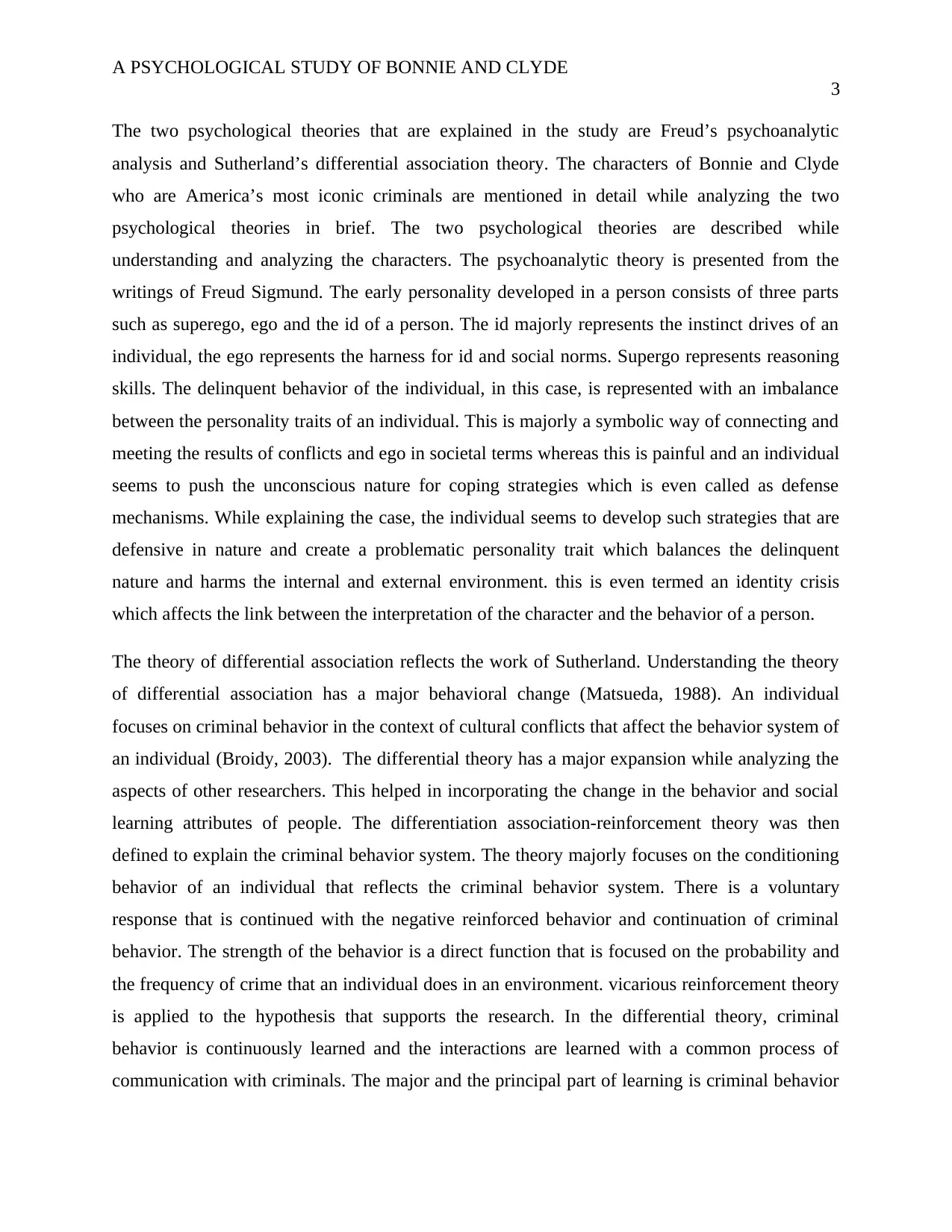
A PSYCHOLOGICAL STUDY OF BONNIE AND CLYDE
3
The two psychological theories that are explained in the study are Freud’s psychoanalytic
analysis and Sutherland’s differential association theory. The characters of Bonnie and Clyde
who are America’s most iconic criminals are mentioned in detail while analyzing the two
psychological theories in brief. The two psychological theories are described while
understanding and analyzing the characters. The psychoanalytic theory is presented from the
writings of Freud Sigmund. The early personality developed in a person consists of three parts
such as superego, ego and the id of a person. The id majorly represents the instinct drives of an
individual, the ego represents the harness for id and social norms. Supergo represents reasoning
skills. The delinquent behavior of the individual, in this case, is represented with an imbalance
between the personality traits of an individual. This is majorly a symbolic way of connecting and
meeting the results of conflicts and ego in societal terms whereas this is painful and an individual
seems to push the unconscious nature for coping strategies which is even called as defense
mechanisms. While explaining the case, the individual seems to develop such strategies that are
defensive in nature and create a problematic personality trait which balances the delinquent
nature and harms the internal and external environment. this is even termed an identity crisis
which affects the link between the interpretation of the character and the behavior of a person.
The theory of differential association reflects the work of Sutherland. Understanding the theory
of differential association has a major behavioral change (Matsueda, 1988). An individual
focuses on criminal behavior in the context of cultural conflicts that affect the behavior system of
an individual (Broidy, 2003). The differential theory has a major expansion while analyzing the
aspects of other researchers. This helped in incorporating the change in the behavior and social
learning attributes of people. The differentiation association-reinforcement theory was then
defined to explain the criminal behavior system. The theory majorly focuses on the conditioning
behavior of an individual that reflects the criminal behavior system. There is a voluntary
response that is continued with the negative reinforced behavior and continuation of criminal
behavior. The strength of the behavior is a direct function that is focused on the probability and
the frequency of crime that an individual does in an environment. vicarious reinforcement theory
is applied to the hypothesis that supports the research. In the differential theory, criminal
behavior is continuously learned and the interactions are learned with a common process of
communication with criminals. The major and the principal part of learning is criminal behavior
3
The two psychological theories that are explained in the study are Freud’s psychoanalytic
analysis and Sutherland’s differential association theory. The characters of Bonnie and Clyde
who are America’s most iconic criminals are mentioned in detail while analyzing the two
psychological theories in brief. The two psychological theories are described while
understanding and analyzing the characters. The psychoanalytic theory is presented from the
writings of Freud Sigmund. The early personality developed in a person consists of three parts
such as superego, ego and the id of a person. The id majorly represents the instinct drives of an
individual, the ego represents the harness for id and social norms. Supergo represents reasoning
skills. The delinquent behavior of the individual, in this case, is represented with an imbalance
between the personality traits of an individual. This is majorly a symbolic way of connecting and
meeting the results of conflicts and ego in societal terms whereas this is painful and an individual
seems to push the unconscious nature for coping strategies which is even called as defense
mechanisms. While explaining the case, the individual seems to develop such strategies that are
defensive in nature and create a problematic personality trait which balances the delinquent
nature and harms the internal and external environment. this is even termed an identity crisis
which affects the link between the interpretation of the character and the behavior of a person.
The theory of differential association reflects the work of Sutherland. Understanding the theory
of differential association has a major behavioral change (Matsueda, 1988). An individual
focuses on criminal behavior in the context of cultural conflicts that affect the behavior system of
an individual (Broidy, 2003). The differential theory has a major expansion while analyzing the
aspects of other researchers. This helped in incorporating the change in the behavior and social
learning attributes of people. The differentiation association-reinforcement theory was then
defined to explain the criminal behavior system. The theory majorly focuses on the conditioning
behavior of an individual that reflects the criminal behavior system. There is a voluntary
response that is continued with the negative reinforced behavior and continuation of criminal
behavior. The strength of the behavior is a direct function that is focused on the probability and
the frequency of crime that an individual does in an environment. vicarious reinforcement theory
is applied to the hypothesis that supports the research. In the differential theory, criminal
behavior is continuously learned and the interactions are learned with a common process of
communication with criminals. The major and the principal part of learning is criminal behavior
⊘ This is a preview!⊘
Do you want full access?
Subscribe today to unlock all pages.

Trusted by 1+ million students worldwide
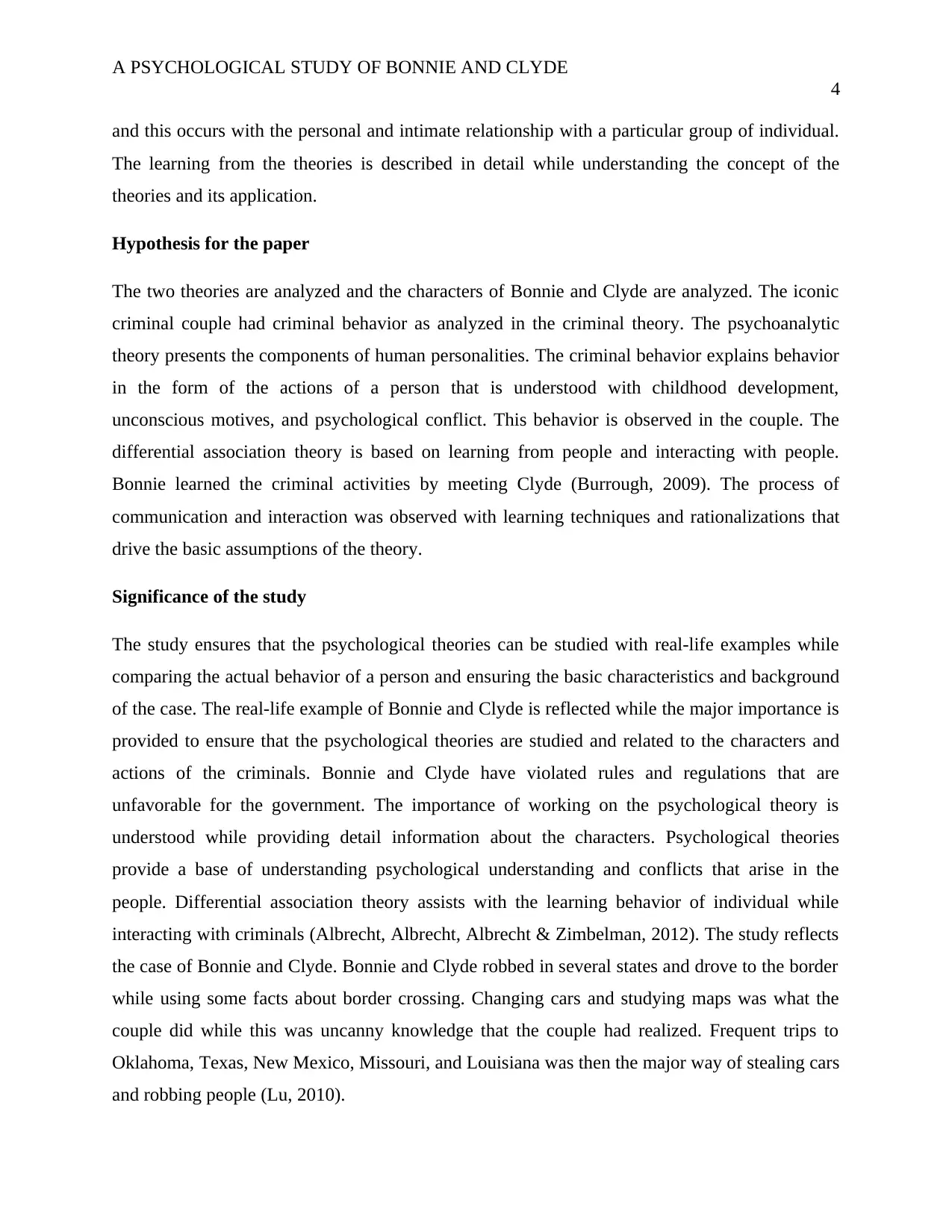
A PSYCHOLOGICAL STUDY OF BONNIE AND CLYDE
4
and this occurs with the personal and intimate relationship with a particular group of individual.
The learning from the theories is described in detail while understanding the concept of the
theories and its application.
Hypothesis for the paper
The two theories are analyzed and the characters of Bonnie and Clyde are analyzed. The iconic
criminal couple had criminal behavior as analyzed in the criminal theory. The psychoanalytic
theory presents the components of human personalities. The criminal behavior explains behavior
in the form of the actions of a person that is understood with childhood development,
unconscious motives, and psychological conflict. This behavior is observed in the couple. The
differential association theory is based on learning from people and interacting with people.
Bonnie learned the criminal activities by meeting Clyde (Burrough, 2009). The process of
communication and interaction was observed with learning techniques and rationalizations that
drive the basic assumptions of the theory.
Significance of the study
The study ensures that the psychological theories can be studied with real-life examples while
comparing the actual behavior of a person and ensuring the basic characteristics and background
of the case. The real-life example of Bonnie and Clyde is reflected while the major importance is
provided to ensure that the psychological theories are studied and related to the characters and
actions of the criminals. Bonnie and Clyde have violated rules and regulations that are
unfavorable for the government. The importance of working on the psychological theory is
understood while providing detail information about the characters. Psychological theories
provide a base of understanding psychological understanding and conflicts that arise in the
people. Differential association theory assists with the learning behavior of individual while
interacting with criminals (Albrecht, Albrecht, Albrecht & Zimbelman, 2012). The study reflects
the case of Bonnie and Clyde. Bonnie and Clyde robbed in several states and drove to the border
while using some facts about border crossing. Changing cars and studying maps was what the
couple did while this was uncanny knowledge that the couple had realized. Frequent trips to
Oklahoma, Texas, New Mexico, Missouri, and Louisiana was then the major way of stealing cars
and robbing people (Lu, 2010).
4
and this occurs with the personal and intimate relationship with a particular group of individual.
The learning from the theories is described in detail while understanding the concept of the
theories and its application.
Hypothesis for the paper
The two theories are analyzed and the characters of Bonnie and Clyde are analyzed. The iconic
criminal couple had criminal behavior as analyzed in the criminal theory. The psychoanalytic
theory presents the components of human personalities. The criminal behavior explains behavior
in the form of the actions of a person that is understood with childhood development,
unconscious motives, and psychological conflict. This behavior is observed in the couple. The
differential association theory is based on learning from people and interacting with people.
Bonnie learned the criminal activities by meeting Clyde (Burrough, 2009). The process of
communication and interaction was observed with learning techniques and rationalizations that
drive the basic assumptions of the theory.
Significance of the study
The study ensures that the psychological theories can be studied with real-life examples while
comparing the actual behavior of a person and ensuring the basic characteristics and background
of the case. The real-life example of Bonnie and Clyde is reflected while the major importance is
provided to ensure that the psychological theories are studied and related to the characters and
actions of the criminals. Bonnie and Clyde have violated rules and regulations that are
unfavorable for the government. The importance of working on the psychological theory is
understood while providing detail information about the characters. Psychological theories
provide a base of understanding psychological understanding and conflicts that arise in the
people. Differential association theory assists with the learning behavior of individual while
interacting with criminals (Albrecht, Albrecht, Albrecht & Zimbelman, 2012). The study reflects
the case of Bonnie and Clyde. Bonnie and Clyde robbed in several states and drove to the border
while using some facts about border crossing. Changing cars and studying maps was what the
couple did while this was uncanny knowledge that the couple had realized. Frequent trips to
Oklahoma, Texas, New Mexico, Missouri, and Louisiana was then the major way of stealing cars
and robbing people (Lu, 2010).
Paraphrase This Document
Need a fresh take? Get an instant paraphrase of this document with our AI Paraphraser
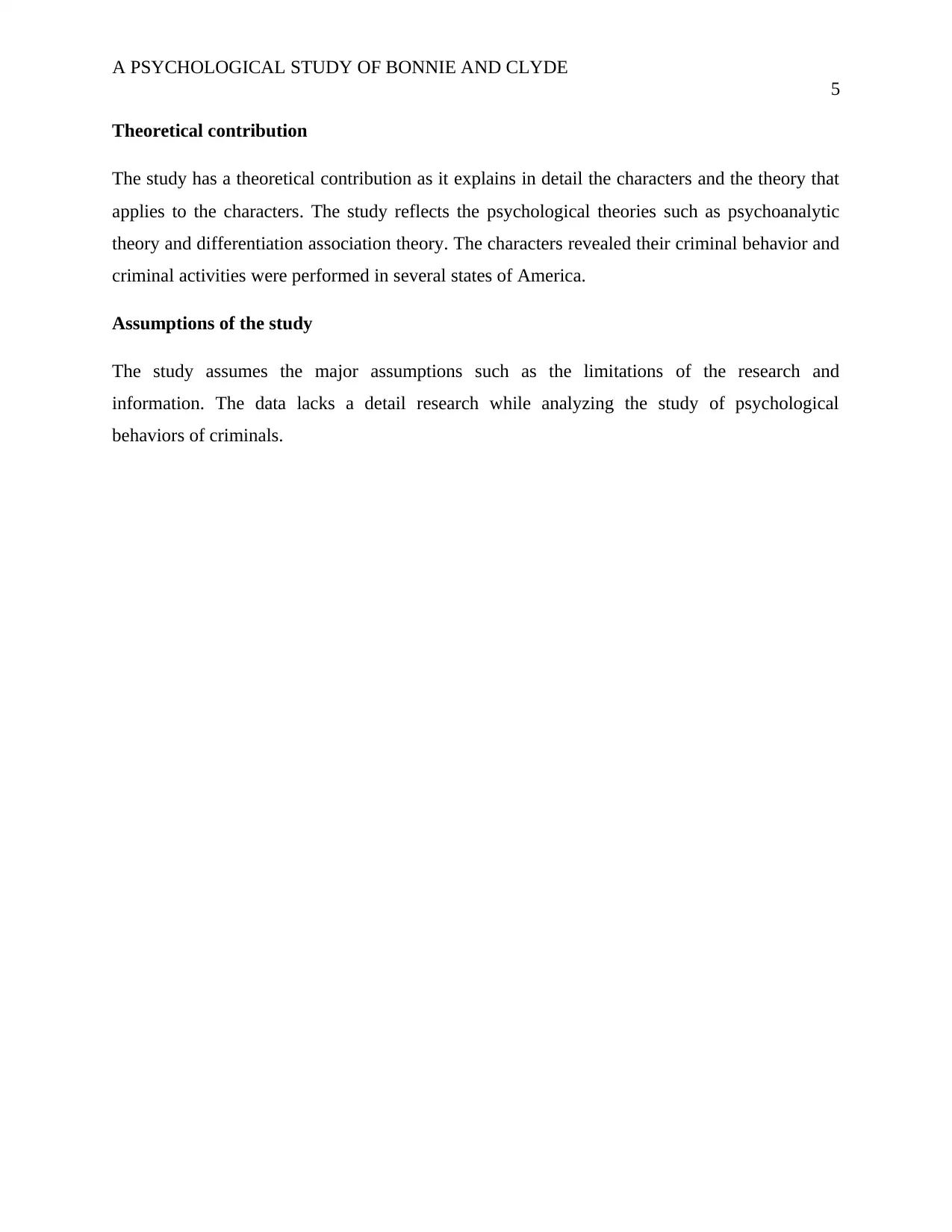
A PSYCHOLOGICAL STUDY OF BONNIE AND CLYDE
5
Theoretical contribution
The study has a theoretical contribution as it explains in detail the characters and the theory that
applies to the characters. The study reflects the psychological theories such as psychoanalytic
theory and differentiation association theory. The characters revealed their criminal behavior and
criminal activities were performed in several states of America.
Assumptions of the study
The study assumes the major assumptions such as the limitations of the research and
information. The data lacks a detail research while analyzing the study of psychological
behaviors of criminals.
5
Theoretical contribution
The study has a theoretical contribution as it explains in detail the characters and the theory that
applies to the characters. The study reflects the psychological theories such as psychoanalytic
theory and differentiation association theory. The characters revealed their criminal behavior and
criminal activities were performed in several states of America.
Assumptions of the study
The study assumes the major assumptions such as the limitations of the research and
information. The data lacks a detail research while analyzing the study of psychological
behaviors of criminals.
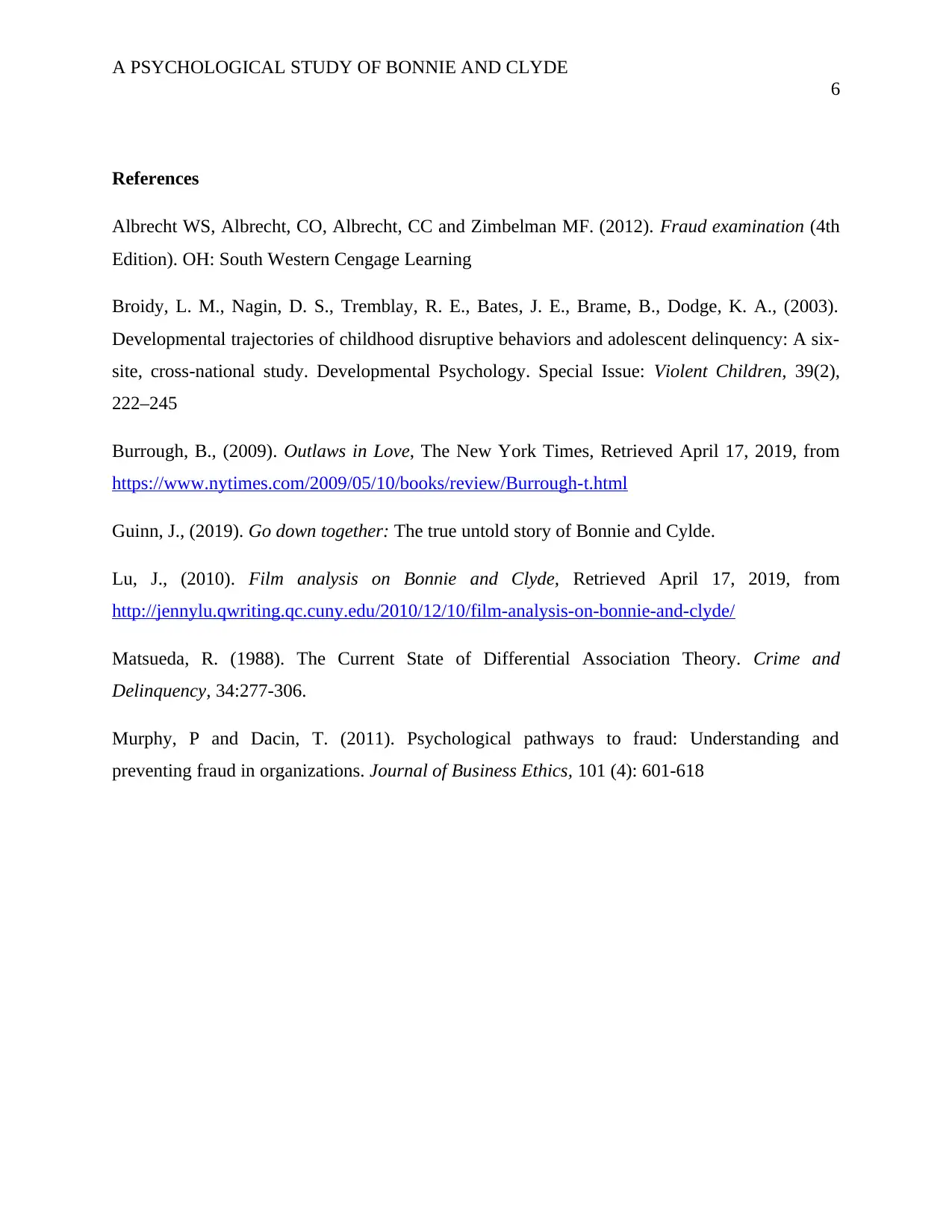
A PSYCHOLOGICAL STUDY OF BONNIE AND CLYDE
6
References
Albrecht WS, Albrecht, CO, Albrecht, CC and Zimbelman MF. (2012). Fraud examination (4th
Edition). OH: South Western Cengage Learning
Broidy, L. M., Nagin, D. S., Tremblay, R. E., Bates, J. E., Brame, B., Dodge, K. A., (2003).
Developmental trajectories of childhood disruptive behaviors and adolescent delinquency: A six-
site, cross-national study. Developmental Psychology. Special Issue: Violent Children, 39(2),
222–245
Burrough, B., (2009). Outlaws in Love, The New York Times, Retrieved April 17, 2019, from
https://www.nytimes.com/2009/05/10/books/review/Burrough-t.html
Guinn, J., (2019). Go down together: The true untold story of Bonnie and Cylde.
Lu, J., (2010). Film analysis on Bonnie and Clyde, Retrieved April 17, 2019, from
http://jennylu.qwriting.qc.cuny.edu/2010/12/10/film-analysis-on-bonnie-and-clyde/
Matsueda, R. (1988). The Current State of Differential Association Theory. Crime and
Delinquency, 34:277-306.
Murphy, P and Dacin, T. (2011). Psychological pathways to fraud: Understanding and
preventing fraud in organizations. Journal of Business Ethics, 101 (4): 601-618
6
References
Albrecht WS, Albrecht, CO, Albrecht, CC and Zimbelman MF. (2012). Fraud examination (4th
Edition). OH: South Western Cengage Learning
Broidy, L. M., Nagin, D. S., Tremblay, R. E., Bates, J. E., Brame, B., Dodge, K. A., (2003).
Developmental trajectories of childhood disruptive behaviors and adolescent delinquency: A six-
site, cross-national study. Developmental Psychology. Special Issue: Violent Children, 39(2),
222–245
Burrough, B., (2009). Outlaws in Love, The New York Times, Retrieved April 17, 2019, from
https://www.nytimes.com/2009/05/10/books/review/Burrough-t.html
Guinn, J., (2019). Go down together: The true untold story of Bonnie and Cylde.
Lu, J., (2010). Film analysis on Bonnie and Clyde, Retrieved April 17, 2019, from
http://jennylu.qwriting.qc.cuny.edu/2010/12/10/film-analysis-on-bonnie-and-clyde/
Matsueda, R. (1988). The Current State of Differential Association Theory. Crime and
Delinquency, 34:277-306.
Murphy, P and Dacin, T. (2011). Psychological pathways to fraud: Understanding and
preventing fraud in organizations. Journal of Business Ethics, 101 (4): 601-618
⊘ This is a preview!⊘
Do you want full access?
Subscribe today to unlock all pages.

Trusted by 1+ million students worldwide
1 out of 6
Your All-in-One AI-Powered Toolkit for Academic Success.
+13062052269
info@desklib.com
Available 24*7 on WhatsApp / Email
![[object Object]](/_next/static/media/star-bottom.7253800d.svg)
Unlock your academic potential
Copyright © 2020–2025 A2Z Services. All Rights Reserved. Developed and managed by ZUCOL.
